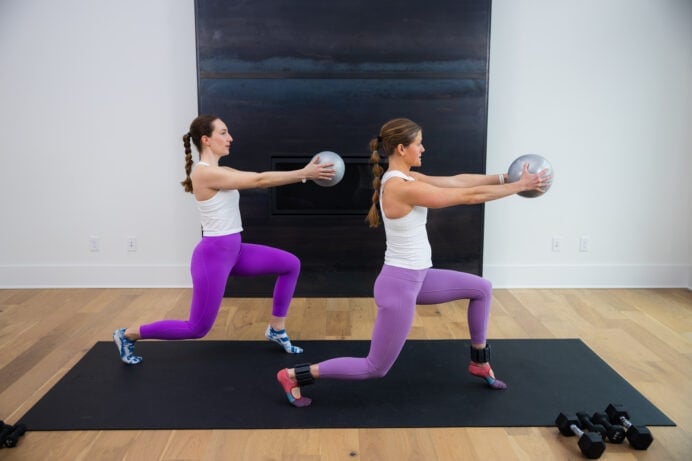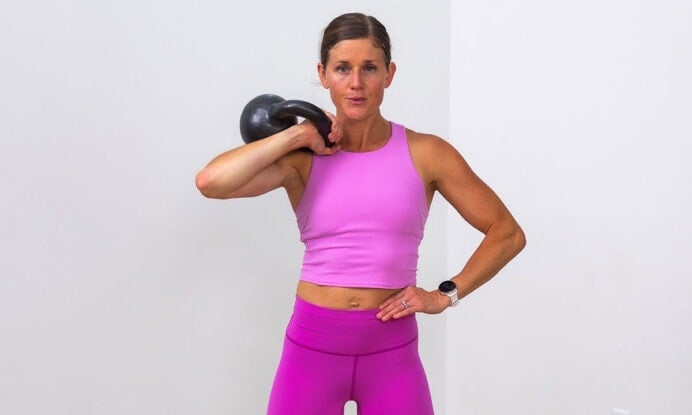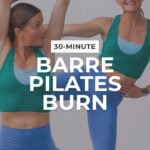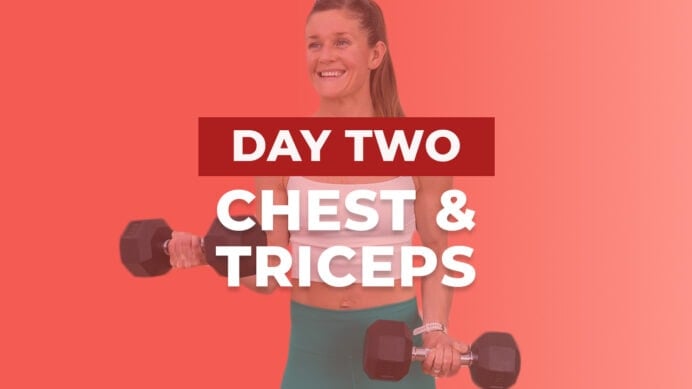
30-Minute Barre Pilates HIIT Class (Full Body)
Build lean muscle, burn calories and increase deep core strength with this full body barre pilates HIIT class. We’ll sweat, sculpt and strengthen every muscle in the body through a combination of barre pilates sequences and HIIT cardio intervals. This fusion-style workout combines the benefits of cardio, strength training, and barre pilates in one dynamic workout.
If you asked me to create a workout that sums up my journey as a fitness instructor, it would be this one.
I started my fitness journey as a barre instructor, before expanding to teaching HIIT and conditioning classes. After having my babies, I focused more on functional strength training and mobility.
Today’s fusion-style barre pilates workout combines elements of strength training, barre/pilates and HIIT cardio.
This keeps the workout mentally-engaging and allows us to reap the health benefits of multiple styles of training:
- Strength training: increases muscle mass, boosts metabolism and increases bone density
- Barre/pilates: increases mobility/flexibility, improves posture and builds deep core strength
- HIIT cardio: burns fat, improves cardiovascular health, and releases endorphins
You don’t need to sign up for expensive reformer or mat pilates classes to achieve your fitness goals.
Barre and pilates workouts are one of the best ways to build strength and muscle tone at home, using limited equipment.

Barre Pilates HIIT Class
Sculpt, strengthen and sweat at home with this full body Barre Pilates HIIT workout.
A full body workout targeting every muscle group in the body: the lower body (quads, hamstrings, glutes, calves, and thighs), upper body (biceps, triceps, back, shoulders, and chest) and core.
Add a pilates barre class like this one to your home workout plan 1-2 times per week to build and maintain strength.
Workout Instructions:
Follow along with the guided Barre Pilates HIIT Workout on YouTube, led by certified personal trainer and barre instructor, Lindsey Bomgren.
Your Workout Looks Like This:
- 30 Minutes of Full Body Barre Pilates Exercises
- Sequenced Flow (moving naturally from one series to the next)
Workout Equipment:
Light to Medium Dumbbells. I recommend between 2-15 lbs depending on your fitness level. We used 10 and 15 lb dumbbells in today’s workout. Option to perform each exercise with no equipment, just your bodyweight.
Workout Outline
- Warm Up
- Plank and Push Up Sequence
- Arabesque Sequence
- Chair and Lunge Sequence
- Pliè and Arms Sequence
- Cardio Intervals
- Mat Pilates Core Series
- Cool Down and Stretch
4 Barre Pilates Exercises
1. Second Position Pliè Squat with Bicep Curl
Targets: Glutes, quads, hamstrings, inner thighs (adductor muscles), biceps and core.

How To Do Pliè Squats with Bicep Curls
- Find second position by stepping wide, heels in, toes facing out towards the corners of the room. Hold a pair of light weights in your hands in front of your hips, elbows bent at 90 degrees and palms facing in towards each other (hammer curl grip).
- Slowly lower your hips, imagining your back is pressed against a wall. Slide your back down the wall, lowering into a wide “squat” position. Tuck your tailbone (anterior pelvic tilt) to engage your core.
- As you lower into a low squat position, alternate curling the dumbbells to your shoulders, performing two bicep curls on each arm as you lower into a low pliè squat. The dumbbells should constantly be in motion.
- Then, reverse the movement, slowly straightening your knees to return to a standing position. Perform four hammer curls as you stand (two per arm), returning to the starting position.
2. Rainbow Leg Lift and Standing Crunch
Targets: Glutes (gluteus maximus, gluteus medius and gluteus minimus), hip flexors, obliques and lower abs.

How To Do Rainbow Leg Lifts and Standing Crunches
- Start standing on your left leg, keeping a soft bend in your left knee. Place your right toes on the mat in front of you, keeping your weight in your back left leg. Option to hold a dumbbell horizontally at your chest.
- Hover your right toes off the mat, then sweep your toes in a large half circle towards the right, ending when your right toes are directly behind your left foot.
- Reverse the motion, returning your right toes to the front of the mat.
- Then, balance on your left leg as you drive your right knee up towards your chest, rotating through your torso to tap left elbow to right knee, performing a standing crunch.
- Slowly and with control, lower your toes in front of your body, returning to the starting position.
3. Reverse Weighted Bird Dog Extension
Targets: Erector spinae, glutes, hamstrings, shoulders, biceps, back and abs.
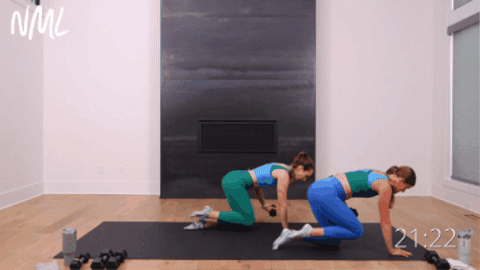
How To Do Reverse Weighted Bird Dogs
- Start in a quadruped position on the floor (on your hands and knees). Engage your core to protect your lower back. Option to hold one dumbbell in your left hand, palm facing up towards the ceiling (reverse grip).
- Extend your right leg back straight behind you, keeping your hips stable. As you kick your right leg back, extend your left arm in front of you, creating a straight line from left fingers to right toes.
- Hold the right leg back and left arm out for a moment, then return to the starting position on all fours.
4. Relevé Glute Bridge March
Targets: Gluteus maximus, gluteus medius, calves, hips, hamstrings and abs.

How To Do Relevé Glute Bridge Marches
- Start laying on your back, feet hip width apart and knees bent.
- Press through your heels to lift your glutes off the mat, squeezing your glutes as you lift. Think about keeping your core engaged and knees in line with your hips.
- Then, shift your weight to your toes, floating your heels off the mat to find a glute bridge relevé. Hold this position.
- Exhale as you drive your right knee towards your chest, before inhaling as you slowly lower your right toes to the mat. Think about keeping your hips stable.
- Repeat, this time driving your left knee towards your chest, before lowering your left toes to the ground with control.
- Continue this pattern, alternating legs with each drive (this is a glute bridge march).
Modification: Perform standard glute bridge marches (with your heels planted on the ground) rather than relevé glute bridge marches.
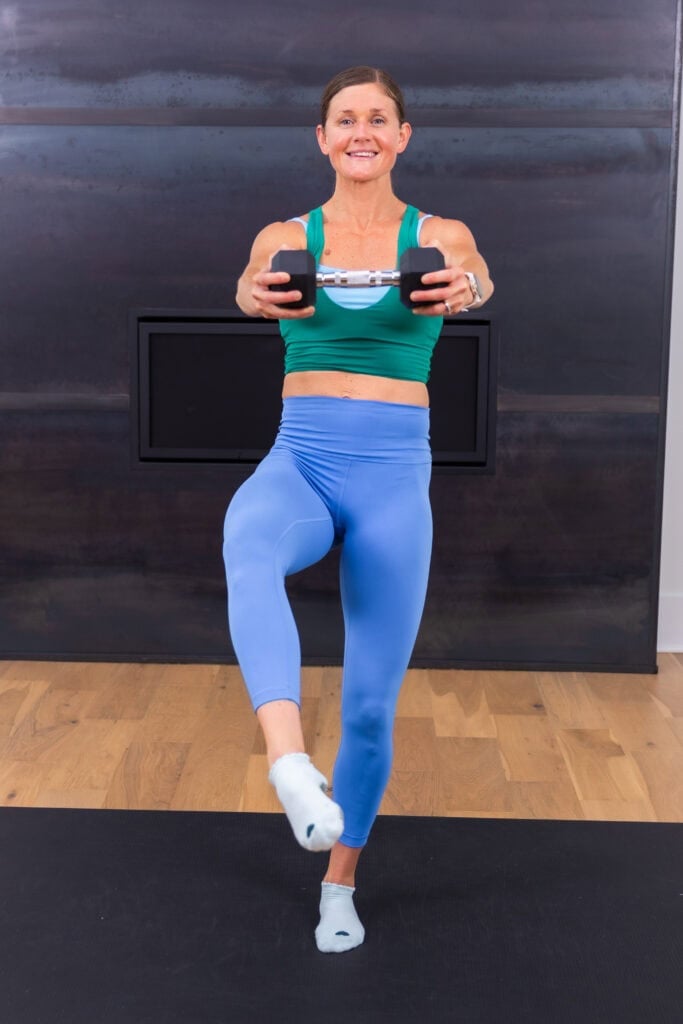
LET’S GET STARTED
Download Your FREE Barre + Pilates Challenge
FAQs
Although both pilates and barre classes are low-impact workouts that focus on core strength, posture and flexibility, there are some key differences. Pilates tends to focus more on slow, controlled movements, with an emphasis on the core. Barre classes tend to be more upbeat, and may include elements of strength training and cardio.
Barre pilates is a hybrid workout that combines elements of ballet barre, pilates, yoga and strength training. It emphasizes challenging core strength and creating long, lean muscles throughout the body. These workouts are also known for improving deep core and pelvic floor strength, increasing flexibility and mobility, and improving balance, posture and mental health.
The “3-2-8 Method” is a type of training that went viral on TikTok for its effectiveness. It combines three days per week of strength training, two days per week of pilates/barre and eight-thousand steps per day.
More Workouts
Barre/Pilates WorkoutsPin This Workout: At-Home Barre Pilates Class

This post includes affiliate links. I do earn a commission for products purchased using these links (at no additional cost to you). Thank you for supporting Nourish Move Love, making the content you see on this blog possible.










